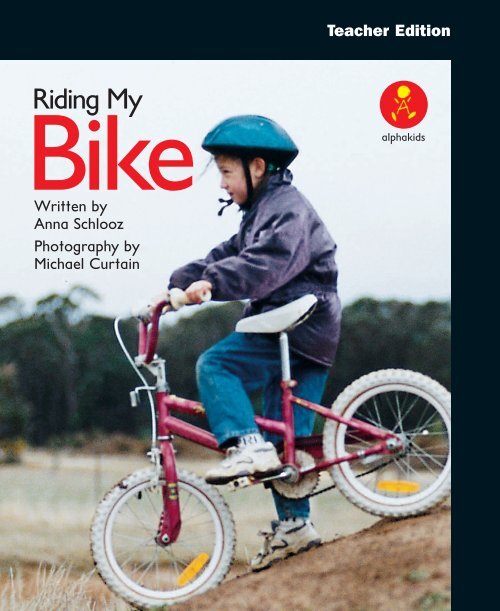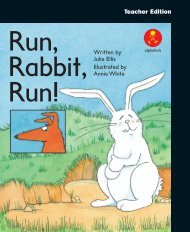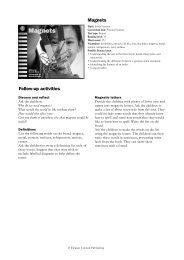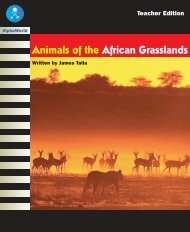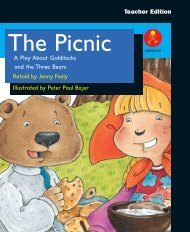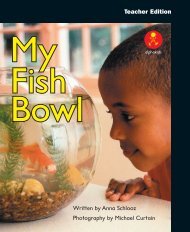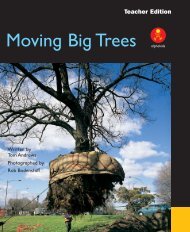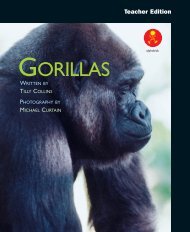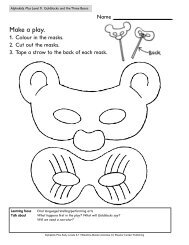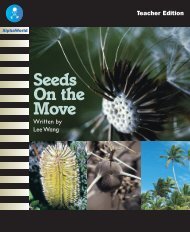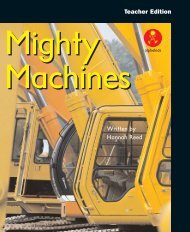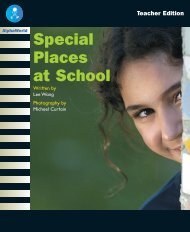Riding My Bike
Riding My Bike
Riding My Bike
- No tags were found...
You also want an ePaper? Increase the reach of your titles
YUMPU automatically turns print PDFs into web optimized ePapers that Google loves.
<strong>Riding</strong> <strong>My</strong> <strong>Bike</strong> Pages 4–5?TalkthroughHere is the girl with her dad. What is he doing?Point out the high-frequency words: a, dad, do, her, me,that, you.Can you see the word ‘me’ on the page?Observe and supportDo the children recognise the high-frequency words: do,you, that, me?Can you show me ‘do’? What about the word ‘that’? I likethe way you are remembering these words. Knowing thesewords will help you to work out new ones.4
<strong>Riding</strong> <strong>My</strong> <strong>Bike</strong> Pages 8–9?TalkthroughNow the girl has ridden into the flowers. What question willshe ask this time? Then what will she say?Observe and supportCan the children support their understanding of the textwith direct evidence from the page?Where does the girl ride her bike this time? Where does ittell you this?8
<strong>Riding</strong> <strong>My</strong> <strong>Bike</strong> Pages 10–11?TalkthroughWhat do you notice about where the girl is riding now? Whatdo you think she will say?How do you think she is feeling about her riding?Observe and supportCan the children make inferences from the text?Is the girl getting better at riding her bike? How do you know?10
<strong>Riding</strong> <strong>My</strong> <strong>Bike</strong> Pages 12–13?TalkthroughWhere is the girl riding now? What does that tell you abouthow good she is at riding her bike? What will she say? Howdo you think she will say it?Observe and supportDo the children read the text with expression, as if theywere the child in the book?Can you read it so that it sounds like the girl talking? Howmight she be feeling? How might her voice sound?12
<strong>Riding</strong> <strong>My</strong> <strong>Bike</strong> Pages 14–15?TalkthroughNow the girl is a good bike rider. She can ride everywhere.Point out that the repeated phrase ‘That’s me!’ is notwritten on this page. Instead, it is held over to thefollowing page.Why do you think the writer did this? Does it make the bookmore interesting?Observe and supportDo the children notice when they make an error?What did you notice? Why was it a problem? What could youtry instead? What would make sense there? What wouldsound right?14
<strong>Riding</strong> <strong>My</strong> <strong>Bike</strong> Page 16?TalkthroughTalk about the photograph.How do you think the girl is feeling now? What tells you this?How would you feel if you had just learned to ride a bike?16After readingBeing a meaning makerEncourage the children to support their answers withevidence from the book as they discuss thesecomprehension questions:Why did the girl ride her bike with her dad at first?What happened when the girl rode near the flowers?What happened to the girl as she learned to ride her bike?How did you know that the girl was getting better at ridingher bike?How did the girl feel when she could ride her bike well?
Being a code breakerExplore the following language features:• Words that rhyme with ‘bike’: hike,like, mike, pike, strike.• Question marks and exclamationmarks to end sentences.• Gender: girl, herself, her; boy,himself, him.Being a text userRefer to the text when discussing thesequestions:Why are the first few photographs in this bookon an angle?What effect does this create?How does this match the story?Being a text criticDo all children learn to ride bikes?Do you want to learn to ride a bike? Why orwhy not?Responding to textThe children could work incooperative groups to draw a mapof all the places the girl went on her bike.They could also include a house and anyother features they might like to add.Innovate on the text. Encouragethe children to recount a learningexperience they have had: ‘Do you seethat boy with his brand new rollerblades? That’s me!’Ask the children to draw a rangeof things that begin with theletter ‘b’. These could be displayed oncards in the shape of a bicycle.WritingDiscuss a skill the children may havelearned; for example, how to catch a ball.List the problems they had as theylearned, then, together, write a short textinnovating on <strong>Riding</strong> <strong>My</strong> <strong>Bike</strong>. Forexample, ‘Do you see that boy catching aball with his dad? That’s me!’AssessmentCan the children:• point out exclamation marks and question marks and say what they mean?• discuss the meaning of the book? Is it easy to learn to ride a bike? Why?whole text activity sentence activity word activity
<strong>Riding</strong> <strong>My</strong><strong>Bike</strong>Written byAnna SchloozPhotography byMichael CurtainalphakidsTeacherEditionOtherbooksat thislevelThe Best Pizzain the WorldWritten by Jenny FeelyPhotography by Ross TonkinalphakidsTopic: HobbiesCurriculum link: SOSEText type: RecountReading level: 5Word count: 86High-frequency words: a, by, do, girl, herself,into, me, see, that, that’s, the, youVocabulary: bike, dad, everywhere, flowers, gate,new, puddle, riding, throughPossible literacy focusUsing question marks and exclamation marks inwriting.Interpreting the text: Is it easy to learn to ride abike? Why or why not?SummaryThis book recounts a girl’s experiences whilelearning to ride a bike.Shut theGate!WrittenThe PondWritten by Hannah Reedby Edel WignellIllustrated by Steve AxelsenalphakidsalphakidsSebastianWritten byJenny FeelyIllustrated byAlex StittNo bicycles inthe parkalphakidsLearns to FlySignsSTOPTriple headerspecial!MonkeysalphakidsWritten by Julie Ellis Photography by Michael CurtainISBN 0- 7253- 3375- 89 780725 333751alphakids


